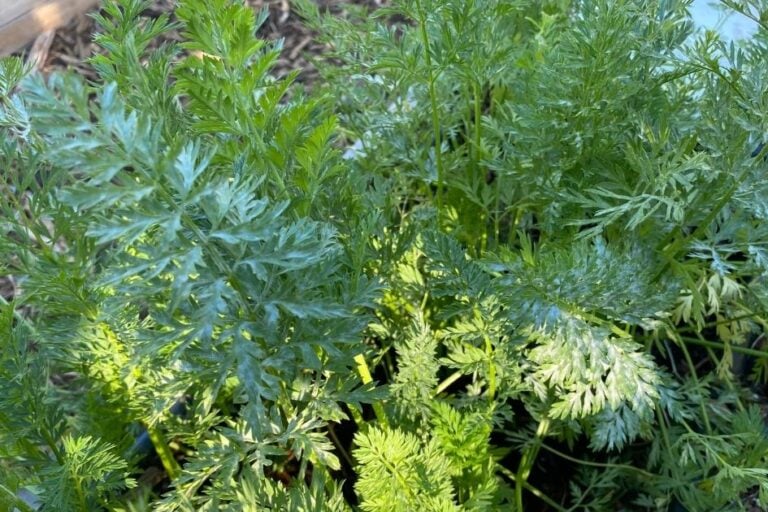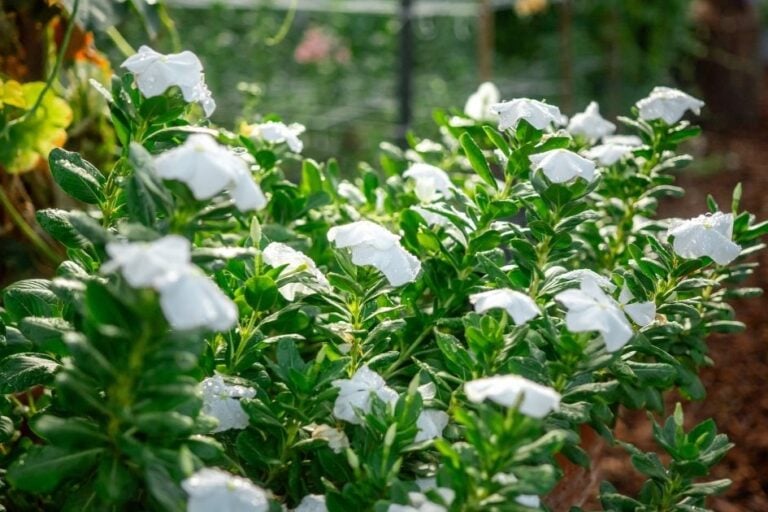Best Companion Plants for Warm-Season Gardens
When planting my garden, I always leave empty spots in each bed for companion plants. These herbs and flowers attract beneficial insects and pollinators, which help control pests and add beauty and diversity to the garden. As the days heat up, your garden can still thrive with the right selection of plants that tolerate the heat and work together to attract beneficial insects, deter pests, and boost overall biodiversity. This post focuses on warm (and hot) season companion plants that are perfect for warm summers. For more insights during the cooler months, check out my posts on Cool Season Companion Planting and Companion Planting Tips.

Quickly Find Warm-Season Companion Plants:
- Lavender
- Sage
- Basil
- Marigold
- Thyme
- Rosemary
- Gaillardia
- Amaranth
- Sesame
- Salvia
- The Benefits of Companion Planting
- Summary Table: Warm-Season Companion Plants
- FAQ About Companion Planting
Lavender
Growing Information: Lavender is a drought-tolerant perennial that thrives in full sun and well-drained soil. I plant lavender in native soil (not raised beds) and don’t overwater.
Varieties to try: Fernleaf, Goodwin Creek Grey, Spanish, and French lavender perform well in the low desert.
Attracts: Lavender’s sweet fragrance and nectar-rich flowers draw in bees and butterflies.
Learn More: How to Grow Lavender

Sage
Growing Information: Sage is a hardy, heat-tolerant herb that tastes as good as it looks. Its silver-green leaves and occasional purple flowers add texture to your garden, and it thrives in hot, dry conditions. Sage grows well in the corner of a raised bed or native soil.
Attracts: The purple blooms of sage are loved by bees and hummingbirds.
Learn More: How to Grow Sage

Basil
Growing Information: Basil is a summer favorite that pairs perfectly with vegetables like tomatoes. It enhances flavor, and its aromatic leaves also help mask the scents that attract pests. Plant a wide variety of basil types and allow some to flower.
Attracts: Basil’s small white or purple flowers attract bees, ensuring a steady pollinator presence during the warm season.
Seed Source: Basil Seeds
Learn More: How to Grow Basil

Marigold
Growing Information: Marigolds are vibrant annuals known for their pest-repellent properties. French marigolds release compounds through their roots that repel nematodes and have a strong scent that keeps aphids, whiteflies, and mosquitoes at bay.
Attracts: These cheerful flowers lure in beneficial insects, such as ladybugs (learn why NOT to buy ladybugs here) and hoverflies, which help keep pest populations in check.
Seed Source: Marigold Seeds
Learn More: How to Grow Marigolds

Thyme
Growing Information: Thyme is a versatile, low-growing herb. It requires minimal water and thrives in full sun, making it ideal for hot climates.
Attracts: Thyme’s delicate blooms attract bees and other pollinators, supporting a healthy garden ecosystem.
Learn More: How to Grow Thyme

Rosemary
Growing Information: Rosemary is a hardy, aromatic shrub that grows best in dry, sunny environments. Its needle-like leaves and occasional blue or purple flowers make it a striking and useful addition to any garden. I plant lavender in native soil (not raised beds) and don’t overwater.
Attracts: Rosemary draws in bees and other pollinators with its fragrant blooms, while its strong aroma may help deter certain pests.
Learn More: How to Grow Rosemary

Gaillardia (Blanket Flower)
Growing Information: Gaillardia is a heat-loving perennial known for its long-lasting, bright red and yellow blooms. It’s exceptionally drought-tolerant.
Attracts: Its vibrant flowers attract bees and butterflies, boosting pollination and enhancing the overall biodiversity of your garden.
Seed Source: Gaillardia Seeds
Learn More: How to Grow Gaillardia

Amaranth
Growing Information: Amaranth is a striking annual with colorful foliage and delicate seed heads. It thrives in high temperatures.
Attracts: Amaranth’s unique blooms are a favorite among bees and other pollinators, while birds often enjoy its seeds, adding an extra layer of natural pest control.
Seed Source: Amaranth Seeds
Learn More: How to Grow Amaranth

Sesame
Growing Information: Sesame is a lesser-known, heat-tolerant crop that offers a unique look with its delicate, tubular flowers. It’s valued for its edible seeds and its ability to adapt to arid conditions.
Attracts: The small, attractive sesame flowers invite bees and other beneficial insects.
Seed Source: Sesame Seeds
Learn More: How to Grow Sesame

Salvia
Growing Information: Salvia has many varieties, but warm-season salvias are particularly noted for their drought tolerance and vibrant flower spikes. They’re perfect for adding vertical interest to your garden.
Attracts: Salvia’s tubular blooms are highly attractive to hummingbirds, bees, and butterflies, making it a magnet for pollinators and beneficial insects.
Seed Source: Salvia Seeds

The Benefits of Companion Planting
Companion planting is a time-tested strategy that creates a balanced ecosystem in your garden. By growing these warm-season plants together, you not only maximize space but also create a natural environment that:
- Attracts Pollinators: Continuous blooms mean that bees, butterflies, and hummingbirds have a reliable source of nectar throughout the season. Discover more about creating a pollinator-friendly garden in my post Perennials for Pollinators in Your Desert Garden.
- Enhances Natural Pest Control: Many of these companions repel pests or attract predators (like ladybugs, hoverflies, and parasitic wasps) that keep harmful insects at bay.
- Boosts Soil Health: A diverse planting palette encourages a robust soil ecosystem, reducing the need for chemical fertilizers and pesticides.
Attracting the right insects can make companion planting even more effective. Read Planting for Pollinators: Create a Simple Insectary Border in Your Garden for ideas that work in any space.

Looking for a creative way to combine companion planting with small-space gardening? Learn how to grow a Three Sisters Garden in grow bags using corn (or alternatives), beans, and squash for a thriving mini-ecosystem. See how I adapted this method to raised beds in my Three Sisters garden.
If you’re planning your garden layout, don’t miss this guide on cucumber companion plants—you’ll find tips on pairing cucumbers with flowers, herbs, and vegetables to improve growth and reduce pests.
Summary Table: Warm-Season Companion Plants
Use the table below as a quick reference for the pollinators they attract, and their primary companion benefits:
| Plant | Pollinators Attracted | Companion Benefits |
|---|---|---|
| Lavender | Bees, Butterflies | Aromatic, adds color, repels pests |
| Sage | Bees, Hummingbirds | Culinary uses, pest deterrence, adds texture |
| Basil | Bees | Enhances flavor of nearby crops, masks pest scents |
| Marigold | Ladybugs, Hoverflies | Repels nematodes and pests, serves as a natural barrier |
| Thyme | Bees, Other Beneficial Insects | Acts as a low-growing ground cover, aids in weed suppression |
| Rosemary | Bees | Aromatic, drought-tolerant, deters pests |
| Gaillardia | Bees, Butterflies | Provides vibrant color, highly drought tolerant |
| Amaranth | Bees, Birds (for seeds) | Ornamental appeal, edible seeds, adds texture |
| Sesame | Bees, Other Beneficial Insects | Well-adapted to arid conditions, offers a unique flavor |
| Salvia | Hummingbirds, Bees, Butterflies | Adds vertical interest, attracts a diverse range of pollinators |
FAQ About Companion Planting
Q1: What is companion planting and why is it beneficial?
A: Companion planting involves growing different plants together to naturally improve pollination, deter pests, and enhance soil health. It creates a balanced ecosystem that reduces the need for chemical interventions.
Q2: Can these warm-season plants thrive in extreme heat?
A: Yes, the plants listed (such as Lavender, Sage, and Gaillardia) are specifically chosen for their heat and drought tolerance, making them ideal for hot climates like Arizona.
Q3: How do I know which beneficial insects are attracted to each plant?
A: Each plant’s growing guide details the primary pollinators and beneficial insects it attracts. For example, Lavender and Rosemary are excellent for attracting bees, while Salvia draws hummingbirds and butterflies.
Q4: Are there any special soil or watering considerations for these plants?
A: Most of these plants prefer well-drained soil and full sun. Utilizing drip irrigation and organic mulch can help maintain consistent moisture levels and reduce water evaporation.
Q5: Where can I find more detailed growing information for each plant?
A: You can click on the growing guide links provided in each plant’s section.
If you have any additional questions, feel free to leave a comment!

In Conclusion
Embracing warm-season companion plants like Lavender, Sage, Basil, Marigold, Thyme, Rosemary, Gaillardia, Amaranth, Sesame, and Salvia can transform your yard into a vibrant, self-sustaining ecosystem. With careful planning and a little attention to each plant’s needs, you can enjoy a productive garden and a haven for beneficial insects and pollinators.








Leave a comment on Best Companion Plants for Warm-Season Gardens